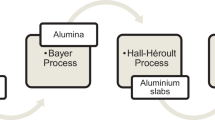Abstract
In order to characterize the complicated corrosive environment around superheater tubes in advanced waste-to-power (WTP) boilers, thermodynamic simulation was conducted using the thermodynamic equilibrium calculation software MALT for Windows. The macroscale of thermodynamically stable compounds at an equilibrium state can be obtained using this software, which is applicable for predicting the macroscale environmental conditions in WTP plants. It was revealed from these calculations that the presence of corrosive gases such as Cl2 derived from HCl may be a corrosive factor in an actual furnace. The calculation results were compared with actual furnace environments by means of other analytical equipment such as IC, ICP–AES, TG–DTA, and fluorescent X-ray analysis. These analytical results suggested the chemical composition, and the local distribution tendency of each element, including the presence of eutectic chloride compounds with low melting points in the ash deposited onto the WTP boiler tubes. On the basis of the comparison between the thermodynamic prediction and different kinds of analytical results, the applicability and limitation of the thermodynamics were discussed.









Similar content being viewed by others
References
Ministry of the Environment, Processing Status and Discharge of General Waste (2012 fiscal year).
K. Takemura, M. Yoshiba, H. Morita, and M. Takakura, JSPS 123 Committee Research Report, 54, 303 (2013).
N. Otsuka, Corrosion Science 50, 1627 (2008).
H. Morita, M. Yoshiba, Y. Suzuki, and M. Takakura, JSPS 123 Committee Research Report, 52, 302 (2011).
M. Yoshiba, in Frontier and subjects of Energy Utilization by Biomass and Waste to Power Generation, ed. M. Yoshiba (S&T Publishers, 2013), p. 146.
H. Yokokawa, Netsu Bussei 7, 63 (1993).
NEDO, Development of High Efficiency Waste Power Generation Technology 1991 Report, 1, 309 (2000).
V. K. Fassler, H. Leib and H. Spahn, Mitteilungen er VGB 48, 126 (1986).
S. Kasaoka, Y. Sakata and M. Shirata, Japan Chemical Journal 11, 1728 (1997).
D. A. Vaughan, H. H. Krause, and W.K. Boyd, in Ash Deposits and Corrosion due to Impurities in Combustion Gases, eds. R. W. Bryers (Hemisphere Publication, New York, 1978), p. 473.
H. H. Krause, in High Temperature Corrosion in Energy Systems, ed. M. F. Rothman (TMS-AIME, Warrendale, 1985), p. 83.
G. Y. Lai, High-Temperature Corrosion of Engineering Alloys, (AMS International, New York, 1990), p. 158.
G. Sorell, Materials at High Temperature 14, 137 (1997).
Acknowledgments
We would like to thank M. Takakura and H. Onodera of JEOL Ltd. and T. Sakaki of Tosoh Co. for advanced analytics and analysis sample preparation.
Author information
Authors and Affiliations
Corresponding author
Rights and permissions
About this article
Cite this article
Sudo, Y., Takemura, K., Yoshiba, M. et al. Thermodynamic Simulation for the Environmental Prediction of High-Efficiency Waste-to-Power Plant Boiler. Oxid Met 85, 297–310 (2016). https://doi.org/10.1007/s11085-015-9584-x
Received:
Published:
Issue Date:
DOI: https://doi.org/10.1007/s11085-015-9584-x




